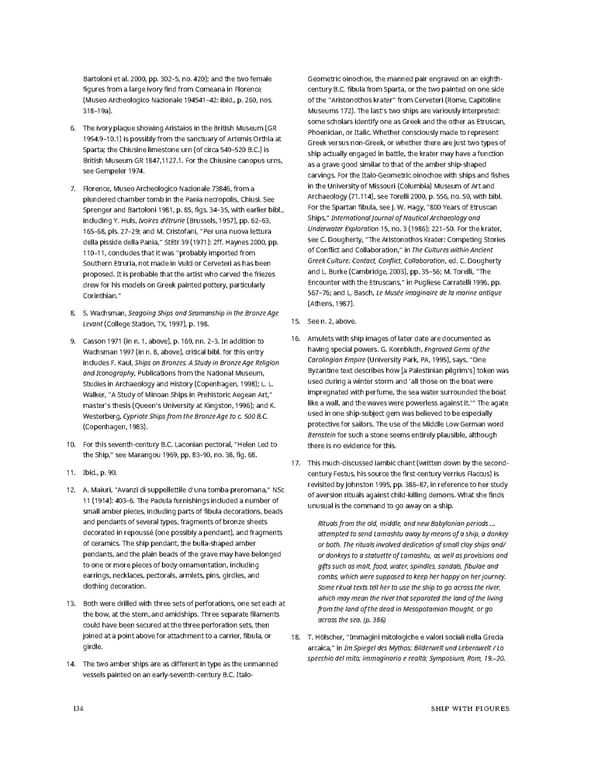Bartoloni et al. 2000, pp. 302–5, no. 420); and the two female Geometric oinochoe, the manned pair engraved on an eighth- figures from a large ivory find from Comeana in Florence century B.C. fibula from Sparta, or the two painted on one side (Museo Archeologico Nazionale 194541–42: ibid., p. 260, nos. of the “Aristonothos krater” from Cerveteri (Rome, Capitoline 318–19a). Museums 172). The last’s two ships are variously interpreted: 6. The ivory plaque showing Aristaios in the British Museum (GR some scholars identify one as Greek and the other as Etruscan, 1954.9–10.1) is possibly from the sanctuary of Artemis Orthia at Phoenician, or Italic. Whether consciously made to represent Sparta; the Chiusine limestone urn (of circa 540–520 B.C.) is Greek versus non-Greek, or whether there are just two types of British Museum GR 1847,1127.1. For the Chiusine canopus urns, ship actually engaged in battle, the krater may have a function seeGempeler 1974. as a grave good similar to that of the amber ship-shaped carvings. For the Italo-Geometric oinochoe with ships and fishes 7. Florence, Museo Archeologico Nazionale 73846, from a in the University of Missouri (Columbia) Museum of Art and plundered chamber tomb in the Pania necropolis, Chiusi. See Archaeology (71.114), see Torelli 2000, p. 556, no. 50, with bibl. Sprenger and Bartoloni 1981, p. 85, figs. 34–35, with earlier bibl., For the Spartan fibula, see J. W. Hagy, “800 Years of Etruscan including Y. Huls, Ivoires d’étrurie (Brussels, 1957), pp. 62–63, Ships,” International Journal of Nautical Archaeology and 165–68, pls. 27–29; and M. Cristofani, “Per una nuova lettura Underwater Exploration 15, no. 3 (1986): 221–50. For the krater, della pisside della Pania,” StEtr 39 (1971): 2ff. Haynes 2000, pp. see C. Dougherty, “The Aristonothos Krater: Competing Stories 110–11, concludes that it was “probably imported from of Conflict and Collaboration,” in The Cultures within Ancient Southern Etruria, not made in Vulci or Cerveteri as has been Greek Culture: Contact, Conflict, Collaboration, ed. C. Dougherty proposed. It is probable that the artist who carved the friezes and L. Burke (Cambridge, 2003), pp. 35–56; M. Torelli, “The drew for his models on Greek painted pottery, particularly Encounter with the Etruscans,” in Pugliese Carratelli 1996, pp. Corinthian.” 567–76; and L. Basch, Le Musée imaginaire de la marine antique (Athens, 1987). 8. S. Wachsman,Seagoing Ships and Seamanship in the Bronze Age Levant (College Station, TX, 1997), p. 198. 15. Seen. 2, above. 9. Casson 1971 (in n. 1, above), p. 169, nn. 2–3. In addition to 16. Amulets with ship images of later date are documented as Wachsman 1997 (inn. 8, above), critical bibl. for this entry having special powers. G. Kornbluth, Engraved Gems of the includes F. Kaul, Ships on Bronzes: A Study in Bronze Age Religion Carolingian Empire (University Park, PA, 1995), says, “One and Iconography, Publications from the National Museum, Byzantine text describes how [a Palestinian pilgrim’s] token was Studies in Archaeology and History (Copenhagen, 1998); L. L. used during a winter storm and ‘all those on the boat were Walker, “A Study of Minoan Ships in Prehistoric Aegean Art,” impregnated with perfume, the sea water surrounded the boat master’s thesis (Queen’s University at Kingston, 1996); and K. like a wall, and the waves were powerless against it.’” The agate Westerberg,Cypriote Ships from the Bronze Age to c. 500 B.C. used in one ship-subject gem was believed to be especially (Copenhagen, 1983). protective for sailors. The use of the Middle Low German word Bernstein for such a stone seems entirely plausible, although 10. For this seventh-century B.C. Laconian pectoral, “Helen Led to there is no evidence for this. the Ship,” see Marangou 1969, pp. 83–90, no. 38, fig. 68. 17. This much-discussed iambic chant (written down by the second- 11. Ibid., p. 90. century Festus, his source the first-century Verrius Flaccus) is 12. A. Maiuri, “Avanzi di suppellettile d’una tomba preromana,” NSc revisited by Johnston 1995, pp. 386–87, in reference to her study 11 (1914): 403–6. The Padula furnishings included a number of of aversion rituals against child-killing demons. What she finds small amber pieces, including parts of fibula decorations, beads unusual is the command to go away on a ship. and pendants of several types, fragments of bronze sheets Rituals from the old, middle, and new Babylonian periods … decorated in repoussé (one possibly a pendant), and fragments attempted to send Lamashtu away by means of a ship, a donkey of ceramics. The ship pendant, the bulla-shaped amber or both. The rituals involved dedication of small clay ships and/ pendants, and the plain beads of the grave may have belonged or donkeys to a statuette of Lamashtu, as well as provisions and to one or more pieces of body ornamentation, including gifts such as malt, food, water, spindles, sandals, fibulae and earrings, necklaces, pectorals, armlets, pins, girdles, and combs, which were supposed to keep her happy on her journey. clothing decoration. Some ritual texts tell her to use the ship to go across the river, 13. Both were drilled with three sets of perforations, one set each at which may mean the river that separated the land of the living the bow, at the stern, and amidships. Three separate filaments from the land of the dead in Mesopotamian thought, or go could have been secured at the three perforation sets, then across the sea. (p. 386) joined at a point above for attachment to a carrier, fibula, or 18. T. Hölscher, “Immagini mitologiche e valori sociali nella Grecia girdle. arcaica,” in Im Spiegel des Mythos: Bilderwelt und Lebenswelt / Lo 14. The two amber ships are as different in type as the unmanned specchio del mito: immaginario e realtà; Symposium, Rom, 19.–20. vessels painted on an early-seventh-century B.C. Italo- 134 SHIP WITH FIGURES
 Ancient Carved Ambers in the J. Paul Getty Museum Page 143 Page 145
Ancient Carved Ambers in the J. Paul Getty Museum Page 143 Page 145